10.31.2005
Galatea v. Thalassa
This year, the trouble begins with two rival space-faring nations on the western shores of the Nereid Ocean, the satellite companies, SpaceSense (50% owned by the government of Galatea, 49% private investors) and NeoImage (100% privately-owned) and sales of high resolution processed images of coastal states during the Fourth North Nereid War between Proteus and Larissa.
Naturally, as the action heat up, mishaps include a New year's eve loss of control of a satellite which subsequently survives re-entry only to crash into and explode in a munitions factory of the warring nation, Proteus. (Oops.)
Yes, for you fans of fake appellate litigation, the 2006 Manfred Lachs Space Law moot court problem, used by all three regions and the world finals, is up: Case Concerning the Sale and Operation of Certain Commercial Remote Sensing Satellites (Republic of Galatea v Kingdom of Thalassa). Download it and get cracking. See you at the world finals, Valencia, Spain, next October.
And now (digital drum roll, please)... SLP congratulates the winners of the 2005 space law moot court competition -- George Washington University Law School's Kristie Blase (J.D. '06) and Olivia Hussey (J.D. '05), and their coach, hot shot space lawyer Steve Mirmina at NASA, in the Case Concerning International Liability, Deltastan v Gammaland. (Fun with space elevators.) The finals took place October 21 in Fukuoka, Japan.
(By the way, as noted in the blog, Mootness, for 2005 champion Ms. Blase, it ain't just space law. She also won the National Animal Law Moot Court Competition. Cudos for that. But come on, compared to the final legal frontier, isn't animal law kinda...tame?)
10.28.2005
Friday Flybys (vol. 22)
 A bunch of items in the hopper that I didn't have a chance to post this week:
A bunch of items in the hopper that I didn't have a chance to post this week:Jeff Foust shares some notes from the COMSTAC meeting including Brant Sponberg's input regarding NASA commercialization efforts.
While merger lawyers for Lockheed and Boeing put together more stacks of info for the FTC, SpaceDev and Starsys sign their merger agreement.
Meanwhile, Thomas James cleverly calculates damages in connection with SpaceX's litigation. (And Rand's readers pick up on it here.)
Li Jing, a researcher with the National Astronomical Observatories, and the most quoted space law expert in China (and like, the only one?) tells Shanghai Daily that that moon for sale thing is baloney, not cheese.
And yes, Beijing is investigating the bogus moon real estate scheme. China's new adventures in space capitalism continue.
Speaking of which...thanks to Shenzhou-6 you'll want to buy Chinese space stocks.
And interesting musings at Rand's place about whether China will get to the moon before "we" do. (Of course that's not counting the fact that we were there 26 years ago.)
But never mind China, in the new issue of Discover, Fred Guterl, ponders the overlooked question, "Will the European Space Agency put astronauts on the Red Planet before NASA does?"
By the way, SpaceRef posts a transcript of House Science Committee hearing, The Future of NASA, (from June 28, 2005).
And how about this, on the shake-up at NASA. (The Washington Post via MSNBC)
I wasn't following this, but SpaceRef reports the House passed an AIA-supported bill "to create a federal inter-agency task force on aerospace workforce revitalization." Sounds good.
The topic of FAA/AST's 4th Quarter 2005 Quarterly Launch Report is Risk Perception and Communication in Commercial Reusable Launch Vehicle Operations. (I usually check AST's site, but Clark got there first.)
Phil Bowermaster of The Speculist (awesome blog) comments on the position of the United Nations Office for Outer Space Affairs regarding moon property, "Gee, why does it upset the UN so much that they can't control the US when they apparently get to call the shots for the entire universe?"
All those cool, cute cubesats... Clark Lindsey has links. And there's even an item from MoFo's September 2005 Communications Law Bulletin on The Dawn of Personal Satellites.
Over on Out of the Cradle, following up on Rob's interview with Sam Dinkin of SpaceShot, Mark now interviews Jon Goff of Masten Space System about his company and insight for new space engineers. Looking foward to how the OoTC blogmasters can top those two interviews. (Unless, Brad Pitt and George Clooney?) (A girl can dream.)
collectSPACE covers the federal criminal trial of former Kansas Cosmosphere director Max Ary, indicted for stealing and selling museum artifacts. Somebody needs a time out.
President Nursultan Nazarbayev of Kazakhstan ratifies a treaty with Russia on the Baiterek rocket complex.
Also on the Russia front, Space.com reports Russia has agreed to launch a Brazilian astronaut to ISS.
Never mind this year's space elevator competition which no one won. It's all about next year.
Greg Olsen exercises his bragging rights.
What else? Oh. With all kinds of far-ranging chapters in Professor Reynolds' new book covering things like small is the new big, where will he fit all the space law material?
Just in time, pumpkin carving lessons.
And you don't have to check the candy calculator.
Now go. Get unusually close to Mars this weekend.
10.27.2005
Riding Russian Rockets
I think the floor statements by Rep. Ken Calvert (R-Corona) and Rep. Sherwood Boehlert (R-New Hartford) cover it.
(Of course, here in the West, we prefer to see the interests of America being served by Russian rockets than those of Iran. And that's all I will say about Iran this week.)
Personal note to Commander Bill McArthur on ISS (who I know reads SLP up there, that is, when he's not watching Houston Astros games) -- looks like your wife won't have to file for that tax extension after all!
Sam's SpaceShot
And here's a hottie. Over on Out of the Cradle, blogmaster Rob Wilson interviews Sam Dinkin, CEO of a cool new space venture, SpaceShot, an online skill game in which players will compete to win a suborbital flight with Rocketplane.
Tune in. Sam talks about his vision for the company, and making space accessible to people who aren't rich.
And Sam says he plans to offer SpaceShot to participants "wherever it's legal." (Ah. Sam hasn't asked me, but if he did, I would immediately recommend world class firm Arent Fox for expert legal advice on contests, sweepstakes and online gaming: they can lead any company through the legal minefields of complex state and international gaming regulations. I am in no way affiliated with the firm.)
(By the way, Sam, whose name is well-known in space media for his writings and contributions in The Space Review and other hot venues, also recently introduced SpaceShot at Michael Mealling's speed dating forum at the Space Frontier Conference, as you might have read on Rand Simberg's live blog of that.)
I'll look forward to giving SpaceShot a whirl.
Let the space games begin.
Confirming Shana
As I've previously posted, SLP supports for the number two post at the space agency, the highly qualified Ms. Dale, who is, among other things, a lawyer and space policy expert.
Go Shana.
10.26.2005
Falcon I almost ready...
________________________________________________
The target launch date for the Falcon I maiden flight is now late November to early December from our island launch complex in the Kwajalein Atoll. All systems will be ready for flight by the end of this week with the exception of Merlin qualification, which we are extending by four weeks for added surety.
The customer for this mission is DARPA and the Air Force and the payload will be FalconSat-2, part of the Air Force AcademyÂs satellite program that will measure space plasma phenomena, which can adversely affect space-based communications, including GPS and other civil and military communications.
There will be web video coverage of the launch and access details will be posted on the SpaceX website in the coming weeks. For video of the May hold down firing at Vandenberg, click here.

Falcon 1 on our launch pad on Omelek Island
Onion space

Mike just couldn't resist. (Well he's only human. What would you do if you had the keys to the soon-to-be obsolete space shuttle jangling in your pocket?) (via NASA Watch)
Moon Plan Blues
Mars Society president Robert Zubrin doesn't have to pay a fee for saying "this policy sucks" in a speech last week at the Space Frontier Conference in L.A. to describe the Vision for Space Exploration in conjunction with NASA's Exploration Systems Architecture Study. "The pertinent issue right now is whether there really will be a Moon-Mars initiative, or whether this is just nice theme music for a rationalization of the space station program,” Zubrin said.
For a range of reasons, many now agree with a negative assessment of the moon initiative, and even early supporters who first viewed ESAS as a good plan to implement the VSE now voice second thoughts.
Jeff Foust, covering the debate over the moon plan, rounds up and gauges "signs of dissent within the community of space activist and enthusiast organizations" in connection with the vision and ESAS.
(And if you missed Jeff's article last week, check out his overview of the lunar exploration plans of Europe, Japan, China, and India, and the issue of international cooperation in future moon missions.)
Much more on moon-Mars exploration to come.
Would space business be as much fun if it was easy? Well, it wouldn't suck.
10.25.2005
FTC wants more on ULA
I don't have a copy of the Second Request; here's the short joint statement issued by Lockheed and Boeing yesterday.
Second Requests are of course typical, I've worked on some of them myself over the years.
(By the way, while we're watching the SpaceX suit, ULA proposed merger, and related matters, I want to disclose: I own Lockheed stock. Since like, 1997. Which of course will cloud my blogging judgement and render my lawyerly objectivity nonexistent. Sure.)
No White Sox Policy
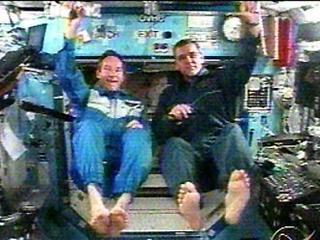 In an unusual policy shift, NASA announced that Expedition 12 Commander Bill McArthur (seen here with Flight Engineer Valery Tokarev, left) "has decreed a 'no white sox' policy onboard the space station and asked Mission Control for a plan to 'trash or jettison' all of the crew's white socks." (Image credit: NASA TV)
In an unusual policy shift, NASA announced that Expedition 12 Commander Bill McArthur (seen here with Flight Engineer Valery Tokarev, left) "has decreed a 'no white sox' policy onboard the space station and asked Mission Control for a plan to 'trash or jettison' all of the crew's white socks." (Image credit: NASA TV)NASA says the move is intended to show the astronauts' "Astros spirit in honor of the Houston baseball team's participation in the World Series." Commander McArthur is reportedly a longtime Houston resident and Astros fan.
However, armchair space policy analysts debated whether the newly announced sock policy in fact covered for an unexpected "wardrobe malfunction" suffered by the crew during last night's game. Meanwhile, NASA declined to respond to charges that recent cost trimming resulted in a shortage of footwear aboard the space station.
Simberg Space
Here's Rand on the spaceflight regulation panel with Jim Muncy of Polispace, Jim Dunstan of t/Space, Randall Clague of XCOR and George Nield of the FAA.
And Rand on the ITAR panel, chaired by Berin Szoka of the Institute for Space Law and Policy, and including Kerry Scarlott, of Posternak, Blankenstein and Lund, Dennis Wingo of Orbital Recovery and Skycorp, and Randall Clague with XCOR.
And Rand on the role of government session, which brough together Mark Schlather, Gary Oleson of Northrop Grumman, Barbara Thompson of NASA Goddard, Tom Matula MBA Professor, Henry Vanderbilt of the Space Access Society, Ed Hudgins of Objectivist Center.
And of course, Rand on Michael Mealling's space tech speed dating showcase.
Read them all. And thanks, Rand.
10.24.2005
SpaceX Rockets to Court
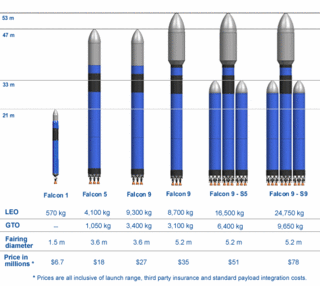 It's a case custom-made for you antitrust space law aficionados.
It's a case custom-made for you antitrust space law aficionados.But no surprise. After all, in May, when Boeing and Lockheed Martin announced their agreement to form United Launch Alliance, a joint venture for government launch services, you expected something like this. Yes, SpaceX has rounded up and sued the usual suspects -- Boeing and Lockheed -- for violating antitrust laws and conspiring to snuff out competition.
And you know when Elon Musk sends in Morrison & Foerster, a firm that made The American Lawyer's "A-List" of the top 20 law firms for the second year in a row, it'll be a firefight. (Elon, who funds SpaceX out of his personal multimillions, has said he can afford three launch failures. Well, maybe two, after this litigation.)
Read Mofo's complaint for plaintiff SpaceX, filed Oct. 19 in U.S. District Court for the Central District of California. (via SpaceRef)
And the battle is on. Defendants will argue, inter alia, that with a contract but no launches, start-up SpaceX is no EELV-class launch competitor of industry giants Boeing and Lockheed.
Interestingly, SpaceX's target launch date for Falcon I's maiden flight is Halloween, which was to be after the FTC's decision was expected on the ULA joint venture. (Falcon I will launch FalconSat-2, part of the Air Force Academy's satellite program to investigate space plasma.) But according to a Reuters item today, the Wall Street Journal has reported the Commission is delaying its decision (which restarts the 30-day clock, again).
(The European Commission cleared the merger in August.)
Stay tuned.
* * *
Update: If Space Exploration Technologies Corporation v. The Boeing Company and Lockheed Martin Corporation inspires you to brush up on antitrust law, or you need some CLE credits, check out the Seventh Annual Sedona Conference on Antitrust Law & Litigation, Nov. 3-4, 2005 in Sedona, Arizona, which will focus on "the role of economics in antitrust, exclusive dealing, joint venture law, the Robinson-Patman Act, the intersection of the patent and antitrust laws, and the trial of an antitrust case." Sponsors include Arnold & Porter and Gray Plant Mooty.
Also, on Dec. 7, Indiana University School of Law offers a course on Competition Law in a Global Context. (And personally, I could use the help.)
10.21.2005
China Flybys
 I've been out of blogtown the past two days, but I'm sure you've all kept up. And today, instead of an installment of Friday Flybys , here's a selection of items from China space.
I've been out of blogtown the past two days, but I'm sure you've all kept up. And today, instead of an installment of Friday Flybys , here's a selection of items from China space.* * *
Surprise, surprise. Notorious U.S. businessman Dennis Hope has found a new market for his faux moon deals. According to China Daily, "China may be years away from a lunar landing but one company is offering a piece of "land" there right now. The so-called Lunar Embassy, through which one can purchase an acre on the moon for 298 yuan (US$37), started operations yesterday in Beijing." (How do you say caveat emptor in Chinese?)
Meanwhile, an item in Xinhuanet quotes Li Juqian, associate professor at the Chinese University of Politics and Law, saying that while other nations have domestic space law, China does not, and "China should set up relevant laws as its space exploration accelerates." And, he specified, the "laws should protect private investment in the aerospace sector as more private parties enter space-related businesses." Li recommended China learn from other countries, and Space Law Probe is standing by with experts who can help. Just drop me an e-mail!
After Shenzhou VI successully completed China's second manned space mission, returning to Earth on Sunday after five days in orbit, director of the China Space Engineering Office Tang Xianming talked up the nation's space plans. An official said the next mission would take place in 2007, and would include a space walk. He also said China "might consider" female astronauts. (Whatever that means.) (AP via CNN)
People's Daily Online reports an Olympic flag orbited the Earth for five days aboard Shenzhou VI with two Chinese astronauts in a "show of China's commitment to the 2008 Games." China will host the 2008 Olympic games (not on the moon, but at home) in Beijing.
And this just in, China's first space tourist ponied up $100,000 for a 90-minute sub-orbital joy ride in 2007. The lucky guy is Jiang Fang, "president of a Hong Kong company that acts as the China agent for U.S.-based space tourism firm Space Adventures." (Reuters via MSNBC)
Finally, is there any truth to the tale that the Great Wall of China is "the only man-made object visible from space"? NASA has the lowdown.
* * *
(By the way, the Chinese quotation at top is, "Set the goal too high and far off!" Courtesy of China the Beautiful.)
10.17.2005
COMSTAC & more
And across town, also on Oct. 26, the National Academy of Sciences is hosting a free public seminar, "Space Settlement: Homesteading on the Moon?," covering lunar property rights issues under international treaties and "the role of such ownership as an incentive for commercial space settlement."
(Of course, if you're stuck at home or just feeling reclusive, you can always just sit back and lurk on, say, a Slashdot thread about space tourism. Bring your own refreshments.)
Everyday space law
And like rock stars, high-flying counsel who practice in the rarefied orbit of space law are now helping to make headlines on the front page of mainstream newspapers. Good example from this weekend (as I catch up with my space lawyer and space law news alerts, and I do have many others, but always read those first), this page one San Francisco Chronicle article pops up in lights: Final frontier for lawyers -- property rights in space: Land claims, commercial schemes and dreams have legal eagles hovering.
Ah. But since when is property rights in space a front page mainstream news item? How come daily newspaper readers are suddenly interested in obscure space law cases like Gregory Nemitz's claim to asteroid 433? Slow news days? No, not lately. Rather, as the age of commercial space and space tourism rockets ahead, emerging issues such as space property law grab the attention and imagination of would-be space tourists, entrepreneurs and explorers everywhere. And these days, a sought-after group of starring space counsel stands by to quickly step and help media outlets figure out the law (or lack thereof) on high.
So what if reporter Keay Davidson calls space law an "emerging circus"? Lawyers have been talking and writing about space stuff for decades. Now everyone's listening: to lawyers like Joanne Gabrynowicz, Jim Dunstan, Rosanna Sattler, Wayne White and many others.
It's a rocking new space law world. (Oh, and along with the front page article, the Chronicle online editors put up a poll which asks the question, do earthlings have a right to claim property rights in space? And the three choices are:
--Yes, we should be able to make a claim for anything that is not owned.
--No, space should remain the province of all beings.
--Only if we can send all the lawyers there.
No kidding. Go see for yourself. (And guess which selection is proving extremely popular? It figures. Well, where do you think Elvis went when he left the building?)
Rock on.
10.14.2005
Friday Flybys (vol. 21)
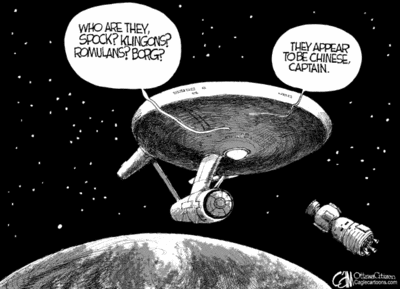 This week, China got the world attention a space power putting crews in orbit deserves. And the public scrutiny of Beijing's space ambitions will only increase. (Although, judging from the China National Space Administration's English-version Web site, where I find no mention of Shenzhou, nothing newsworthy appears to be underway at all lately.)
This week, China got the world attention a space power putting crews in orbit deserves. And the public scrutiny of Beijing's space ambitions will only increase. (Although, judging from the China National Space Administration's English-version Web site, where I find no mention of Shenzhou, nothing newsworthy appears to be underway at all lately.)I'm not an aficionado of China's emerging program, but China space expert Dr. Joan Johnson-Freese tells New Scientist, "China is fortunate in that it is probably the only country in the world that can successfully implement a space programme, because it doesn't have to respond to public opinion." She sees the U.S.'s refusal to allow China to participate in the International Space Station as "the last venue of Cold War politics," saying "It's not clear what kind of technologies we're afraid they are going to get. High-resolution reconnaissance is not something you usually put on a space station."
However, in her Tech Central Station column, Melana Zyla Vickers sees it differently, warning that beyond China's "ostensibly peaceful ambitions lie more militaristic ones..." And other commentary, for example, this editorial in Investor's Business Daily seems to agree.
Meanwhile, over in Japan, while the Space Generation Congress convenes (greetings from Space Law Probe to friends in Fukuoka), an editorial in The Daily Yomiuri says Japanese officials concerned with space development may have underestimated China's advance into space, and the Japanese government should overhaul its space strategy.
On a brighter note for Japan, Alan Boyle reports the next space tourist could be Japanese businessman Daisuke Enomoto.
Back home, trust Keith Cowing to guide us through a closer look at NASA's moon exploration plan.
And as promised, Jon Goff thoroughly blogs the three-day Alliance for Commercial Enterprises in Space (ACES) conference at NASA Ames. Grab all the posts at Selenian Boondocks.
Jeff Foust bravely makes contact with some cosmic legislation.
Prof. Joanne Gabrynowicz tells the The Daily Mississippian why tourists sign away rights for the chance to go into space.
If you miss Rand Simberg when he's on vacation (as many in blogspace do), don't hesitate to pull up some of his classic stuff; I recommend, for example, The Path Not Taken, from The New Atlantis (summer 2004), in which he leaves no space myth standing.
Oh. And I'm sorry but I don't get it about all the advance buzz and excitement surrounding Professor Reynolds' hot new book, coming out early 2006. Inexplicably, the book is not a follow up to his world-renowned space law text. Never mind. While the Professor publishes the wrong bestselling book, and the planet lines up to buy it, here on Space Law Probe we can at least take comfort in some tasty recipes, you know, from his little blog ;-). (Yumm.)
For now, you won't see this intelligent design trial on Court TV. (But you never know, you might see these astronaut-eating dragons attacking the space station on Sci-Fi channel.)
Welcome back to Earth, Greg Olsen.
---------------------
Update, Oct. 17th: Thanks for dropping by, Instapundit fans! But listen -- can we all please stop pre-ordering zillions of copies of Professor Reynolds' new book on Amazon? Predictably, An Army of Davids is already shooting through the sales rankings, while not a single truck will even fuel up to begin shipping the book for months. I insist that the Professor is misdirecting his talents. Writing this book, an opus covering a plethora of meaty current issues that have nothing to do with space law, is just another example of distractions that prevent him from focusing on the more critical task: to update his space law treatise. Let's all just keep away from the Amazon link and stop encouraging him, shall we? Come on, it's for his own good.
10.13.2005
Young explorers unite

I dig the theme of the Space Generation Congress 2005, the annual meeting of the Space Generation, taking place in Fukuoka, Japan, Oct. 14-16, 2005: Explorers wanted: Out of the cradle, into action.
Indeed. The future of earthlings in space is in the hands of the generation that starts with these more than 160 delegates from 35 countries who are gathering to share "the vision of young people on the future utilization and exploration of space."
A great global network of space minded youngsters -- up-and-coming scientists and engineers, businesspeople, innovators and leaders (lawyers, too) of the new space era. Explorers, all. What are they thinking and saying? Listen in on Space Generation forums.
Some background on the main event via the SGC site: the Congress is organised by the Space Generation Advisory Council (SGAC) in support of the United Nations Programme on Space Applications - "the only body through which students' and young professionals' views are represented to the United Nations Committee on the Peaceful Uses of Outer Space (UN COPUOS). SGC 2005 is officially endorsed by the United Nations Office of Outer Space Affairs (UN OOSA), and is officially held in conjunction with the International Astronautical Congress (IAC)."
YOu bet, SGC 2005 delegates who hang around after the weekend are welcome to hobnob with the professional community who are participating in IAC in Fukuoka, Oct. 17-21. Who will have the cooler ideas about "new possibilities for the space community" -- the grownups, or the youth? Well, we can guess.
10.12.2005
Speed dating for space companies

Michael Mealling is playing space matchmaker again. And that's good for space biz.
Here's how it works: At the Space Frontier Foundation's Conference in Los Angeles on October 21st - 23rd, Michael Mealling (of RocketForge) will be hosting -- or shall I say, chaperoning? -- a panel similar to the popular one he ran at Return to the Moon 2005, in which space entrepreneurs got an opportunity to present a five minute sales pitch or presentation to introduce their space product, project or company to an audience which in turn got to ask questions. Great way to network and market your stuff.
By the way, Michael says the panel is open to anyone "doing business in or with the space industry" so if you're a space lawyer with particular expertise or services to offer growing space companies, why not drop Michael a note and ask to get on the line-up?
After all, if you don't talk to strangers, you don't make any friends.
Good luck!
Congratulations, China
As T. L. James on MarsBlog notes, China has now launched twice as many manned spacecraft in the past two and a half years as the US.
Here's a policy paper on China's Space Activities, from China National Space Administration.
This is an obligatory piece on China's Space Ambitions Potential Threat To US.
And Keith Cowing links to an Oct. 2003 Congressional Research Service report to Congress, China's Space Program: An Overview. (via SpaceRef)
Meanwhile, Space Law Probe sends the message, Gong Shyi Jong Kwo
10.11.2005
Move over INA
Dinerman terms INA "perhaps the best example of ineffective US sanctions" and argues "the best hope for NASA and the Administration on Capitol Hill is that the Senate’s bill will be passed intact by the House. This would allow NASA to immediately begin working with the Russians on the future Soyuz missions and would give everyone some breathing space to consider what to do next. After the shuttle has resumed assembly flights to the ISS there will be time for Mike Griffin and his superiors in the White House and Congress to work out exactly what they want NASA to do after 2012."
Las Cruces Chronicles

I was away and off screen for a few days (--alas, not in New Mexico) so I'm quickly catching up with X Prize Cup recaps from the eventful weekend. Here's a good sampling:
Jeff Foust reports on the space show, including the triumph of XCOR's EZ-Rocket which everyone says was the show-stopper, brought out of retirement to fly at at Las Cruces, as well as Starchaser's oxygen/kerosene rocket which went up in a blaze of well, not quite the same kind of glory as the EZ. (Never mind, there's always next year's Cup.) Jeff notes that although there were scrubbed launches and a few VIP cancellations (Buzz Aldrin and Governor Richardson were both MIA, but we're sure neither has lost that lovin' feeling), a large crowd did turn out, thus there's "plenty of room for growth as the so-called 'personal spaceflight revolution' gathers momentum in the years to come..."
Leonard David sums it up for Space.com.
Michael Belfiore offers his own live blogging.
Clark Lindsey logs his observations and insights (and I was going to link to his six or seven individual posts but heck, just open Clark's blog and read everything. And not just during XP Cup season, either.
And of course Alan Boyle reports on New Mexico's space future, along with more XP Cup news.
Thanks guys. See you all there next year.
10.07.2005
Friday Flybys (vol. 20)
 No, that's not Alan Boyle giving the thumbs up with the crew aboard ISS. It's U.S. multimillionaire businessman Greg Olsen, of course, making orbital history as the world's third tourist in space. He's enjoying the digs after his launch from Kazakhstan Oct. 1, ride to the space station aboard Soyuz, and docking with the space station on Oct. 3. He says it's "like camping out." But no bears or mosquitoes. And oh, that $20 million dollar view.
No, that's not Alan Boyle giving the thumbs up with the crew aboard ISS. It's U.S. multimillionaire businessman Greg Olsen, of course, making orbital history as the world's third tourist in space. He's enjoying the digs after his launch from Kazakhstan Oct. 1, ride to the space station aboard Soyuz, and docking with the space station on Oct. 3. He says it's "like camping out." But no bears or mosquitoes. And oh, that $20 million dollar view.Meanwhile, Alan Boyle is in Las Cruces also making space history and thinking about next steps.
With all the hoopla about the X Prize Cup, don't forget Gov. Bill Richardson's announcement that the first launch from New Mexico’s Southwest Regional Spaceport will take place in March, 2006 and that UP Aerospace, Inc. will have the honor. Three launches are planned for 2006, twelve for 2007 and up to thirty in 2008.
Meanwhile, Jon Goff is skipping the X Prize Cup and attending instead an interesting forum at NASA Ames organized by the Alliance for Commercial Enterprises in Space. (We'll also be watching for the latest on the hot Google/NASA deal.)
Mission details remain sketchy but China is reportedly making final preparations for Shenzhou 6 possible launch October 13. And yes, commercialism matters in China space, too.
Daniel Schmelzer has an update on GAO's dismissal of SpaceX EELV bid protests.
Keith Cowing, making an interesting observation, asks, how much to paint a U.S. flag on a Russian rocket?
Taylor Dinerman reviews Everett C. Dolman's Astropolitik: Classical Geopolitics in the Space Age.
Canada commemorates five years involvement in the International Charter: Space and Major Disasters.
Curiously, Jonathan Glater's article on lawyer bloggers and their blawgs in the New York Times today did not mention Space Law Probe. An oversight, I'm sure.
And if you're on safari or anywhere in Africa without cable modem access, Tim Remley and Jessica Martell suggest you get your own satellite connection -- simply buy the dish and rent your own satellite. We can hear you now.
Have an up weekend. If you're heading out for a night on the town don't forget your iPod subway maps. If you're slow cooking a stew, e-mail Professor Reynolds for his special recipe (with Guinness). (The professor is busy on his new book which we understand is not an updated space law treatise. This time. However, there's always another book where that came from.)
And to everyone enjoying the festivities in New Mexico, whatever you do, don't forget what Lord Kelvin said in 1895: "Heavier-than-air flying machines are impossible."
10.06.2005
"This is Your Space Program"
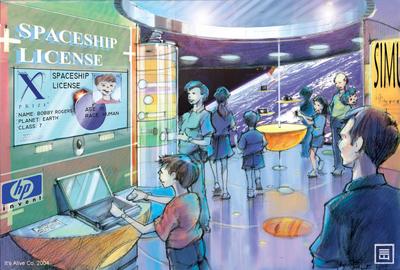 This graphic was designed by X Prize Cup promoters specifically for Space Law Probe. It depicts a young space traveler applying online for a "spaceship license." Other space tourists are awaiting their turn. The application process is simple and requires no lawyers.
This graphic was designed by X Prize Cup promoters specifically for Space Law Probe. It depicts a young space traveler applying online for a "spaceship license." Other space tourists are awaiting their turn. The application process is simple and requires no lawyers.No, I'm kidding. I don't know who created this graphic, I found it in the X Prize press kit. And yes, you bet you'll need a team of lawyers to get your spaceship license. Until further notice.
But there is good news one year after SpaceShipOne took home the $10 million X Prize. Lots of it. Rocket racing and all kinds of stuff. So if you're an up-and-coming space lawyer, entrepreneur or tourist, and you're not in or on your way to New Mexico, you better hit the road.
(As for me, my niece -- a future Mars explorer herself -- is in town this weekend and I'll be taking her to the Hayden Planetarium at the American Museum of Natural History, which is a few blocks from my apartment in Manhattan. But . . .) I'll be checking in with everyone who's blogging live from the long-awaited 2005 Countdown to the X Prize Cup, and all the hot ticket events including the symposium on the future of spaceflight at New Mexico State University in Las Cruces, educational activities at the New Mexico Museum of Space History in Alamogordo, and Personal Spaceflight Expo at the Las Cruces International Airport on October 9th.
Have a blast.
(And while you're there, give my regards to Peter Diamandis and Governor Bill Richardson.)
10.05.2005
What Mike meant to say
Foam Theory
In an interview yesterday with AP, Wayne Hale, manager of the space shuttle program, said workers may have accidentally cut or crushed the section of foam that broke off Discovery's fuel tank during its liftoff.
"This foam, which normally is not touched after it's applied, clearly was touched," he said.
If the worker error, as opposed to fatal design flaw, theory turns out to be correct, perhaps the two and a half years and billion plus dollars NASA spent on post-Columbia fixes and safety (WaPo) may have proved fruitful after all.
And as to any worker accidentally touching the foam, you better believe that won't happen again.
WIA Panel
On the panel: Will Whitehorn (Virgin Galactic), Chris Faranetta (Space Adventures), Diane Murphy, (formerly of X-Prize Foundation) and Janice Starzyk (Futron).
RSVP to: Karen McCann. Lawyers allowed.
10.03.2005
Rocket Racing on Earth
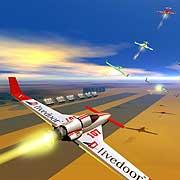 Reminds you of Star Wars: Episode I -- The Phantom Menace, doesn't it?
Reminds you of Star Wars: Episode I -- The Phantom Menace, doesn't it?Flyers, gets your FAA rocket plane licenses and start your liquid oxygen/kerosene fueled X-Racer engines...
Vroooooooom. I missed the fanfare at the Yale Club here in downtown New York yesterday, but could have heard the wow's all the way across town as high-flying Dr. Peter H. Diamandis, founder of the X PRIZE, unveiled his latest airborne innovation: the Rocket Racing League.
Picture it:
Rocket races will operate much like auto races, with the exception that the 'track' is up in the sky. Courses are expected to be approximately two miles long, one mile wide, and about 5,000 feet high, running perpendicularly to spectators. The rocket planes, called X-Racers, will take off from a runway both in a staggered fashion and side-by side and fly a course based on the design of a Grand Prix competition, with long straight-aways, vertical ascents, and deep banks. Each pilot will follow his or her own virtual 'tunnel' or 'track' of space through which to fly, safely separated from their competitors by a few hundred feet.There'll be teams, sponsors, t-shirts, tours, advertising, a video game, lots more. The finals will happen each October in New Mexico at the X-Prize Cup.
Upon take-off, onlookers will easily follow the race as the rocket planes remain in view and sport 20-foot rocket plumes. Fans can also track their favorite pilots' progress via large screen televisions and hand-held GPS tracking devices using WiFi to stream video of the cockpit, live 'on-track' shots, 'side by side' views and wing angle views.
Fans at home will be treated to a three-dimensional course where the 'tracks' pilots are following can be seen. Special effects for lap completions, barrier violations and penalties will also be a part of the show.
Peter Diamandis is a genius.
Even the FAA's Patricia Smith is a fan of rocket racing. She said, "The FAA salutes the Rocket Racing League on its mission to usher in a new era in aerospace entertainment. We look forward to working with the RRL to secure all the necessary licenses and permits to ensure safe and exciting events for the public."
And not a moment too soon. After all, all work and no rocket racing would make for a pretty dull 21st century, wouldn't it?
To Boldly Go Back?
"Of the 58 editorials reviewed, just over half--30--had a decidedly negative reaction to NASA's exploration plans. Of the rest, 16 supported the plan, while the remaining 12 were either neutral or split on the plan, expressing both positive and negative sentiments."
And, sure enough, "in the vast majority of those editorials, the cost of the plan, $104 billion, weighed heavily in their opposition."
Of course, ongoing war coupled with a pair of killer hurricanes did not serve NASA's interests when it came to precision timing of the ESAS announcement.
Jeff concludes,
In the immediate term--the 2006 budget--NASA probably has little to worry about, since the House and Senate have passed versions of the budget that effectively fully fund the agency once again. However, as the budget cycle starts again for 2007 in just a few short months, NASA will have to expect sharp questioning from members of Congress and their constituents about the exploration plan. NASA has done an admirable job providing a first-order answer of how it plans to return to the Moon. The agency now needs to better explain why it deserves in the years to come the tens of billions of dollars needed to turn that plan into rockets, spaceships, and footprints on the Moon.






